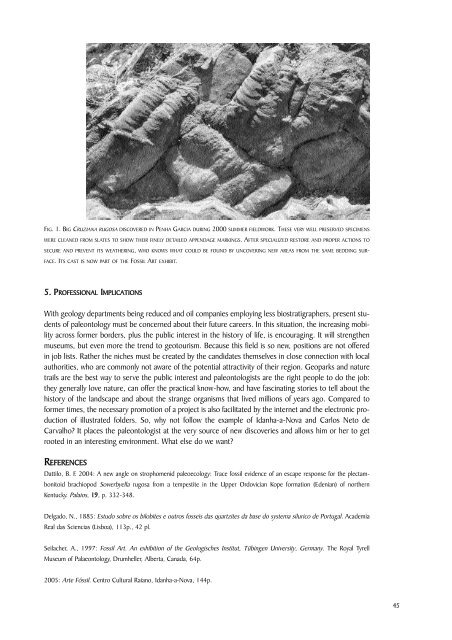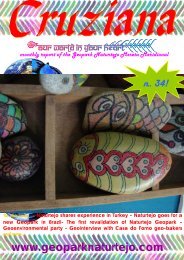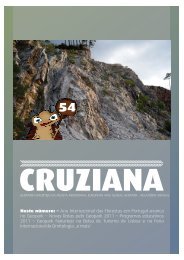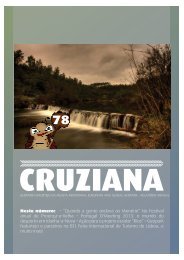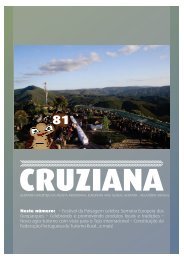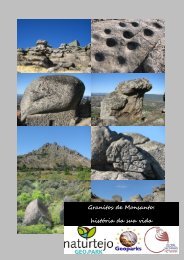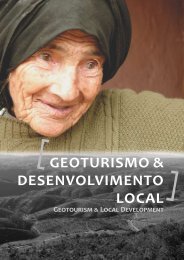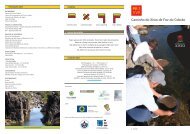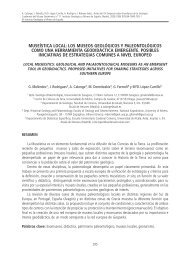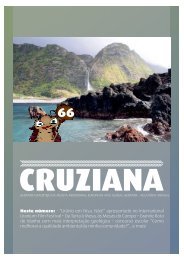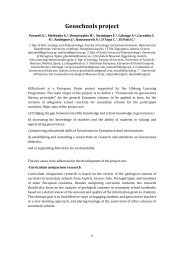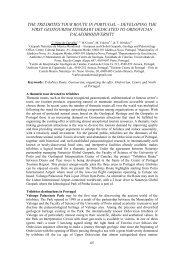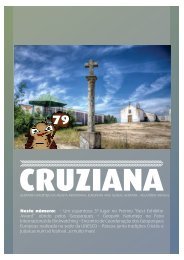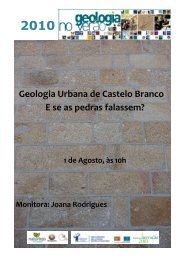FIG. 1. BIG CRUZIANA RUGOSA DISCOVERED IN PENHA GARCIA DURING 2000 SUMMER FIELDWORK. THESE VERY WELL PRESERVED SPECIMENSWERE CLEANED FROM SLATES TO SHOW THEIR FINELY DETAILED APPENDAGE MARKINGS. AFTER SPECIALIZED RESTORE AND PROPER ACTIONS TOSECURE AND PREVENT ITS WEATHERING, WHO KNOWS WHAT COULD BE FOUND BY UNCOVERING NEW AREAS FROM THE SAME BEDDING SUR-FACE. ITS CAST IS NOW PART OF THE FOSSIL ART EXHIBIT.5. PROFESSIONAL IMPLICATIONSWith geology <strong>de</strong>partments being reduced and oil companies employing less biostratigraphers, present stu<strong>de</strong>ntsof paleontology must be concerned about their future careers. In this situation, the increasing mobilityacross former bor<strong>de</strong>rs, plus the public interest in the history of life, is encouraging. It will strengthenmuseums, but even more the trend to geotourism. Because this field is so new, positions are not offeredin job lists. Rather the niches must be created by the candidates themselves in close connection with localauthorities, who are commonly not aware of the potential attractivity of their region. <strong>Geopark</strong>s and naturetrails are the best way to serve the public interest and paleontologists are the right people to do the job:they generally love nature, can offer the practical know-how, and have fascinating stories to tell about thehistory of the landscape and about the strange organisms that lived millions of years ago. Compared toformer times, the necessary promotion of a project is also facilitated by the internet and the electronic productionof illustrated fol<strong>de</strong>rs. So, why not follow the example of Idanha-a-Nova and Carlos Neto <strong>de</strong>Carvalho? It places the paleontologist at the very source of new discoveries and allows him or her to getrooted in an interesting environment. What else do we want?REFERENCESDattilo, B. F. 2004: A new angle on strophomenid paleoecology: Trace fossil evi<strong>de</strong>nce of an escape response for the plectambonitoidbrachiopod Sowerbyella rugosa from a tempestite in the Upper Ordovician Kope formation (E<strong>de</strong>nian) of northernKentucky. Palaios, 19, p. 332-348.Delgado, N., 1885: Estudo sobre os bilobites e outros fosseis das quartzites da base do systema silurico <strong>de</strong> Portugal. Aca<strong>de</strong>miaReal das Sciencias (Lisboa), 113p., 42 pl.Seilacher, A., 1997: Fossil Art. An exhibition of the Geologisches Institut, Tübingen University, Germany. The Royal TyrellMuseum of Palaeontology, Drumheller, Alberta, Canada, 64p.2005: Arte Fóssil. Centro Cultural Raiano, Idanha-a-Nova, 144p.45
INVENTÁRIO DOS GEORRECURSOS, MEDIDAS DE GEOCONSERVAÇÃO E ESTRATÉGIAS DE PROMOÇÃOGEOTURÍSTICA NA REGIÃO NATURTEJOCarlos Neto <strong>de</strong> Carvalho > Gabinete <strong>de</strong> Geologia e Paleontologia do Centro Cultural Raiano <strong>de</strong> Idanha-a-Nova. AvenidaZona Nova <strong>de</strong> Expansão, 6060-101 Idanha-a-Nova. paleo@walla.comABSTRACT<strong>Naturtejo</strong> is a company with the aim of promoting the economical <strong>de</strong>velopment based on tourism. Thedistricts joined in <strong>Naturtejo</strong>, Castelo Branco, Idanha-a-Nova, Nisa, Oleiros, Proença-a-Nova e Vila Velha<strong>de</strong> Ródão, have a total area of more than 4600km2. In this vast region, characterized by a cultural heterogeneityjustified by natural and historical criteria, the geology can be a standardizing component, sincethe geological evolution was controlled here, grosso modo, by the same principal stages which molted thelandscape. It is for the need of territorial standardization that Geology is acclaimed, without prece<strong>de</strong>nceat national level, as anchor theme in a broad scale economical project already in an implementation stage.As an area with historical low level of economic <strong>de</strong>velopment, <strong>Naturtejo</strong> has today one of the most genuineculture traditions as well as natural and historical-archeological heritages. Low level of human impactover the nature is evi<strong>de</strong>nt by the existence of the International Tejo Natural Park. To this offer is ad<strong>de</strong>d theGeology as <strong>Naturtejo</strong> strong bet towards Cultural Tourism, a kind of tourism that allows the visitor to readthe landscape in all ways he wants. It is the quest for originality <strong>Naturtejo</strong> seeks for a sustainable tourism:Geology has the explanation for most of the natural phenomena that enrich the landscapes, some untilnow neglected (granite morphologies or ancient mines) or admired by their obscurity (Penha Garcia ichnofossils,Portas do Ródão gorge or Conhal do Arneiro Roman gold mine), allowing conservation an<strong>de</strong>njoyment measures. Moreover, regional Geology interacts with other cultural features such as settlementsevolution and building, traditional economic activities or popular religion.From this link between a diversified Geology, with local to international important geomonuments, and severalmultidisciplinary components of the <strong>Naturtejo</strong> cultural patrimony emerged the project to candidatethis area to the European <strong>Geopark</strong>s Network, based on three basic premises: inventory, conservation andpromotion. Only with an accurate knowledge of the geological heritage will be possible to program theprotection of endangered geotopes and the management of tourism promotional strategies, purposingtourist packets, thematic routes…Actions un<strong>de</strong>rtaking are the protection by municipal laws of the Penha Garcia river gorge and Ponsul faultroadcut (Idanha-a-Nova), granite forms in Serra da Gardunha (Castelo Branco) and the silicified tree atPerais (Vila Velha <strong>de</strong> Ródão), the classification of Portas do Ródão gorge (Vila Velha <strong>de</strong> Ródão and Nisa)as national Natural Monument, the implementation of geotrails in several places along the territory, theopening of the Quarryman Museum at Alcains (Castelo Branco) and the Geomining Museum at Segura(Idanha-a-Nova). Still at a planning level is the creation of the Paleontological Complex in Penha Garcia,which will involve the Paleozoic Museum and an Interpretation Centre for the Ichnological Park of PenhaGarcia, already with a fast increasing number of visitors.1 – A NATURTEJO E O GEOTURISMO46A <strong>Naturtejo</strong> é uma empresa intermunicipal <strong>de</strong> capitais maioritariamente públicos que nasce em 2004 como objectivo <strong>de</strong> criar condições para o <strong>de</strong>senvolvimento económico assente no Turismo. Os concelhos quecompõem a <strong>Naturtejo</strong>, nomeadamente Castelo Branco, Idanha-a-Nova, Nisa, Oleiros, Proença-a-Nova eVila Velha <strong>de</strong> Ródão, possuem uma área total <strong>de</strong> cerca <strong>de</strong> 4600km2, correspon<strong>de</strong>ndo a municípios daBeira Baixa e Alto Alentejo (distritos <strong>de</strong> Castelo Branco e Portalegre). Nesta vasta região, pautada poruma heterogeneida<strong>de</strong> cultural fundamentada em critérios históricos e mesmo naturais, a Geologia surgecomo elemento uniformizador, já que a evolução geológica <strong>de</strong>sta região foi regida, grosso modo, pelasmesmas etapas fundamentais que, ao longo <strong>de</strong> milhões <strong>de</strong> anos, moldaram a paisagem. E os elementosconstrutores da paisagem são ubíquos, embora criadores <strong>de</strong> diversida<strong>de</strong>: vastas áreas aplanadas com


